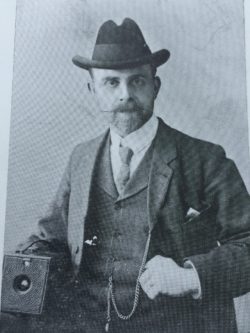The Howdills and Lawnswood Cemetery

The first child ever cremated at Lawnswood Cemetery in Leeds was Dorothy Howdill, who died of scarlet fever in 1905: she was the daughter of local architect and photographer Charles B. Howdill and his wife Laura (née Garth). The Howdills were pillars of the Primitive Methodist Church: Charles’s architect father Thomas was circuit steward at the now long-demolished Rehoboth Chapel in Park Lane, where Charles served as organist for more than 50 years. Three sons and three daughters survived into adulthood.
Charles Barker Howdill (1863-1941) was something of a local character. As a student at the Leeds School of Art, Howdill was quite a prodigy, winning a string of prizes for his drawings, including a National Gold Medal for designing a post office. After working as an assistant architect for the Leeds School Board, he was made an Associate of the Royal Institute of British Architects before joining his father’s architectural practice in 1893.
Over the next 15 years Howdill built numerous chapels and other ecclesiastical buildings all over the country, as well as houses and commercial properties that included a cinema and some mills. Their most famous Leeds buildings were the Branch Road Primitive Methodist Chapel in Armley – better known today as Mike’s Carpets – and Beckworth Tannery in Kirkstall. Their architectural practice has been examined in an authoritative book chapter by Leeds historian Colin Dews. But the Howdills’ bread-and-butter commissions came from the Primitive Methodist community, which fell into decline before the Great War. In later years, Howdill earned his living mainly by teaching building-related subjects at colleges in the West Riding of Yorkshire, notably at Huddersfield Technical College.
Howdill’s greatest passion was photography – and  presenting public lectures at which he showed his slides. By 1897 he had begun lecturing on relatively conventional topics such as Yorkshire cathedrals, but before long he became best known for his travelogues. He took long trips to lesser-visited parts of the European continent in the first years of the twentieth century, which formed the basis for snappily-titled talks such as ‘Corsica – Isle of Unrest’ and ‘The Blazing Balkans’. In his inaugural address as president of the Leeds Camera Club in 1901, he criticized the fashion for ‘pictorialism’ – photography emulating art – and called for more practical, documentary applications of the new technology, to capture ways of life for posterity.
presenting public lectures at which he showed his slides. By 1897 he had begun lecturing on relatively conventional topics such as Yorkshire cathedrals, but before long he became best known for his travelogues. He took long trips to lesser-visited parts of the European continent in the first years of the twentieth century, which formed the basis for snappily-titled talks such as ‘Corsica – Isle of Unrest’ and ‘The Blazing Balkans’. In his inaugural address as president of the Leeds Camera Club in 1901, he criticized the fashion for ‘pictorialism’ – photography emulating art – and called for more practical, documentary applications of the new technology, to capture ways of life for posterity.
Howdill’s slide shows were full of personal anecdotes, convivially recounted. He regaled many audiences with a favourite story of being  taken for a spy in Serbia. Howdill also presented himself as an endlessly inquisitive observer of local customs: one of his lecture flyers announced a special interest in ‘Feasts, Fairs and Funerals’. At times Howdill would stop at nothing to get a good shot: he was bitterly disappointed in 1912, when a visiting French lion tamer would not permit him to enter the animals’ cage.
taken for a spy in Serbia. Howdill also presented himself as an endlessly inquisitive observer of local customs: one of his lecture flyers announced a special interest in ‘Feasts, Fairs and Funerals’. At times Howdill would stop at nothing to get a good shot: he was bitterly disappointed in 1912, when a visiting French lion tamer would not permit him to enter the animals’ cage.
Despite Howdill’s extensive travels, some of his best photographs were the colour shots of his young family which he took and developed at home in Hanover Square, Leeds. Those of his young daughters Dorothy, Madge and Marion offer tantalizing, ethereal evocations of irretrievably lost times: small girls clutching teddy bears (a very recent invention when the pictures were taken in 1911) and dressing up in outlandish outfits. He was an early adopter of the Sanger Shepherd and French Autochrome technologies, and was among the first five photographers ever to exhibit colour images at the Royal Photographic Society in 1901.
Charles B. Howdill was a man of strong opinions that reflected his eminently practical turn of mind: he was once quoted in the Manchester Guardian declaring that trousers were a ridiculous invention, and advocating a return to togas. Howdill’s early support for the idea of cremation was surely an example of his embrace of scientific rationalism and his enthusiasm for new technologies.
The first cremation held at Lawnswood was on 4 January 1905. Dorothy Howdill, eight years old, of 24 Abyssinia Street, was cremated on 15 July 1905. It was only the seventh cremation ever held in Leeds, and the first of a child. Her cremation was authorised by her father and her ashes were only the second to be buried in Lawnswood, in a dedicated plot for cremated remains, well before the opening of the Columbarium in 1933.
An article published in the Dundee Telegraph on 30 September 1904 charting the growth of crematoria states:
Twenty years ago there was no public cremation in this country’… ‘When it is remembered how the practice at first shocked the mass of the public and in some quarters, determined opposition has had to be overcome, the figures [of those cremated since 1885] seem very significant.
Nevertheless, the Howdill family apparently faced a degree of opprobrium for their decision to have Dorothy cremated.
 In due course, Charles and Laura were themselves cremated at Lawnswood, as was their daughter-in-law Edith. A memorial stone to the couple also bears the names of their daughters Dorothy, Marion and Madge.
In due course, Charles and Laura were themselves cremated at Lawnswood, as was their daughter-in-law Edith. A memorial stone to the couple also bears the names of their daughters Dorothy, Marion and Madge.
Leeds Civic Trust installed a blue plaque at Howdill’s former home in Hanover Square, Leeds in 2018, in a fitting act of recognition for the remarkable life and works of a richly talented Yorkshireman.
Duncan McCargo
Many thanks to Colin Dews, Janet Douglas, Nicky Howdill, Ann Lightman and Kate Vernon for their assistance.
This article first appeared as a Grave Spotlight on the Friends of Lawnswood Cemetery website.
Contact email for questions or comments d.j.mccargo@leeds.ac.uk

